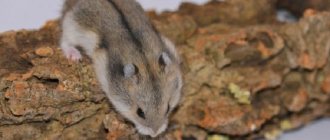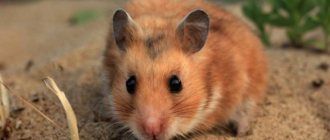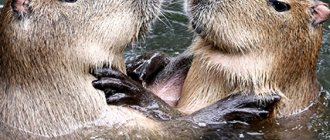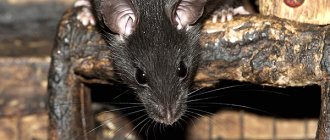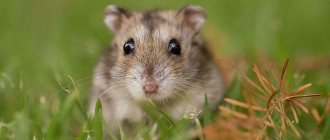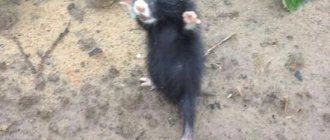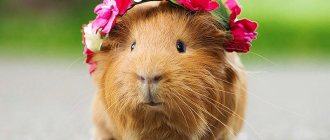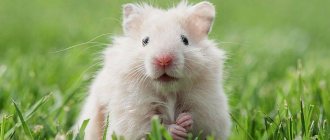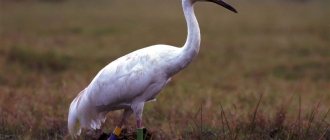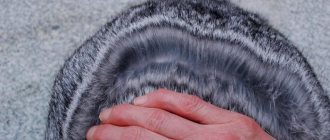03.03.2021 16,283 Hamsters
Author: Olga
In the wild, they do not live as long as their domesticated counterparts. After all, it can be very difficult for these furry animals to maintain their lives in an environment uncontrolled by people. Rooks, herons, foxes, kites, weasels, ferrets - this is not a complete list of the mortal enemies of cute furry creatures. And the farmers, whom the little gluttons manage to antagonize with their raids on fields and vegetable gardens, are not always kind to these animals. Let's talk about the secrets of survival of wild hamsters.
[Hide]
Description of wild hamsters
Hamsters belong to the class mammals, order rodents and family hamsters.
Of the 19 existing species of these animals, 12 live in our country, belonging to six genera:
- real;
- average;
- gray;
- hairy legs;
- rat-like;
- Eversmannov.
Appearance
Behind this dry textbook list are cute, nimble creatures with beady eyes, sharp teeth and soft thick fur. Depending on the species, wild hamsters are the size of a small mouse or a good rat. – The body length of the smallest hamster is five, and the largest is 34 centimeters. The tails also vary in length: from 0.7 to 10 centimeters.
You can find out what adult individuals of individual species look like from this table:
| Species (genus) / Exterior parameters of an adult individual | Common hamster (of the true genus) | Roborovsky's hamster (genus of hairy legs) | Rat-like hamster (rat-like hamster) |
| Body length | 20–34 cm | 5 cm | 18–25 cm |
| Tail length | 6–7 cm | The tail protrudes a few millimeters | Up to 10 cm |
| Weight | 0.5 kg | 0.01 – 0.03 kg | Up to 0.24 kg |
| Color | Yellowish-brown with black, with white markings on the sides | Sandy with a golden tint, the fur above the eyes and on the belly is white | On the back it is brown and grey-brown, softly turning into white in the belly area. |
| Peculiarities | The ears are small, the muzzle is blunt, the front legs resemble human hands | The ears are large, vertical, and there is a white “mask” on the muzzle. | The tail resembles a rat's only in length: in individuals of this species it is pubescent, often with a white tip |
Sexual dimorphism in some species of wild hamsters is unusually expressed: males are smaller than females. All types of hamsters have very strong, sharp teeth and developed cheek pouches.
Interesting facts about hamster teeth:
- Hamsters have only four teeth;
- hamster teeth have no roots;
- Hamsters' teeth never stop growing;
- Hamsters wear down their teeth on a stone.
Habitat
The geography of habitat of hamsters is Central European and Eastern European regions, Syria, Iran, South Korea, China, Mongolia, Siberia. Animals can be found in deserts, mountains, and forests, but wild hamsters most readily inhabit the steppe and forest-steppe zones.
However, to meet a hamster, you don’t have to go deep into the forest, climb the mountains or look for feather grass steppes. – These wild rodents happily settle in cultural landscapes near human buildings. Their raids on agricultural lands cause significant damage to farmers.
A video from the TERRA television and radio company will tell about the battle for the harvest waged by summer residents from the suburbs of Samara with wild hamsters. Details of this battle are in this video.
Steppe hamster
The steppe hamster (common) bears little resemblance to its domesticated relatives. This is one of the most warlike species of the hamster family: it can attack both a large dog and a person. Cases have been recorded of common hamsters eating rabbits.
The aggression of steppe hamsters is often directed at their own brothers: rival candidates for a menstruating female are simply torn to pieces by the strongest male.
The animal is nocturnal, hiding underground at a depth of up to one and a half meters during the daytime. Its hole is a complex structure: a real labyrinth up to 8 meters long, where light and sounds do not penetrate.
It is impossible to count how many different rooms there are in this home. However, among them there is one in which the common hamster sleeps, and a pantry, and even a toilet.
A thrifty owner, the common hamster stores up to 90 kilograms of food in its hole. Of course: in the wild, the animal constantly lives in its hole during the 5 coldest months of the year.
Like any member of the hamster family, the common hamster is a territorial animal. He protects the area in which he lives and which he considers his own. The zone of male common hamsters covers an area of up to 12 hectares! Females also have their own territory. It is smaller and is protected by its nearest neighbor. As a rule, males take several females under their wing at once.
forest hamster
Despite their name, forest hamsters do not only live among trees. Their predominant habitat is North American forests, deserts and prairies. The forest hamster can be found near human buildings, in gardens and vegetable gardens.
There is no single way of life among forest hamsters. They live together and alone, and sleep both day and night.
The forest hamster, which lives not far from people, sleeps during the day. And at night, people will be reminded of his presence by the sounds of brushwood that the animals collect for their hut nests. Rodents build their structures on rocks, at the base of trees, and on the trees themselves. It happens that the forest hamster climbs to a height of six meters!
The forest hamster does not sleep in winter, but can fall into torpor. Like other hamsters of the hamster family, baby forest hamsters are born blind, but with teeth!
Field hamster
The field hamster, like the forest hamster, is a “foreigner”. After all, he lives in Ecuador, Colombia and Canada. These animals very rarely encroach on agricultural land, preferring to settle in tropical forests: mangroves are just right for them. You can find field hamsters both on the prairies and in the swamps.
In appearance, field hamsters resemble house mice of black, gray, orange and brown colors. What makes the field hamster's appearance unusual is its scaly tail. True, it is not easy to see the white scales, since they cover the inner (lower) part of the tail. The outer (top) is covered with fur, painted in dark colors.
Adults of field hamsters vary greatly in size: their body length can be 5 or 20 centimeters!
Habitat
The wild hamster is distributed almost everywhere. The habitat of the carbysh covers the Caucasus, Siberia, Altai and the Crimean Peninsula. The hamster is found in Kazakhstan, China and many European countries.
Previously, the animal lived in the steppe, forest-steppe and mixed-grass meadows. But due to large-scale deforestation, the rodent's distribution area has expanded significantly. The wild hamster successfully colonizes gardens, fields, orchards and summer cottages. And if there is a lack of food, the animal can settle in living quarters.
On a note. A wild hamster alone is capable of destroying the lion's share of the crop. Therefore, in dachas you need to pay attention to signs of the presence of a pest. The steppe rodent leaves characteristic marks, digs at the roots of carrots and potatoes, and also eats the bark at the very bottom of trees.
Living conditions in nature
One way or another, even the largest individuals are just small animals among the huge number of predators surrounding them. What is it like for a hamster in the wild? What helps him survive?
Nutrition
Hamsters cannot get enough of food of plant origin only. Although in the spring they eat the first shoots and young greens, their main food is tubers, seeds, berries, carrion and insects.
These thrifty animals store tens of kilograms of seeds, legumes, grains and potatoes in their underground storerooms.
Being crepuscular animals, wild hamsters begin to hunt after dark.
Reproduction
The love language of female hamsters is their smell. It is by smell that the male finds his girlfriends (as a rule, there are several of them). The season during which wild hamsters breed begins in April and ends at the end of October, when the animals do not sleep.
Exactly how long the pregnancy of hamsters lasts depends on their type (from 15 to 22 days). The first litter of the season appears by May. The number of cubs in one litter ranges from several to a dozen (rarely - up to eighteen individuals).
Having impregnated his girlfriend, the male does not stay with her. His mission is over; he does not take part in raising the cubs.
All babies are born with their eyes closed, and only on about the tenth day do little hamsters begin to see clearly. Two-week-old animals are already completely covered with fur. At the same time, along with mother's milk, the cubs eat greens.
Female hamsters are caring parents. But only before their children reach “adulthood,” which occurs in hamsters at 21 days. From this day on, the young animals are able to take care of themselves, so everyone is looking for their own territory. Hamsters can become parents at the age of 42–56 days.
Anatomy and appearance
Rodents in nature reach a size of 30-35 cm, body weight reaches 700 g. Females are smaller than males. The body is tightly knit and rounded, the neck is slightly pronounced. The head smoothly transitions into the body. The ears are short and rounded. The tail is short, up to 3-6 cm. At first it is thick, tapering towards the tip.
The front and hind legs are short. The claws are strong and well adapted for digging the ground. Hamsters' teeth gradually wear down and grow back throughout the animal's life. The fur is dense, with a thick undercoat. The predominant color is brown, with large white and black spots. There are animals of gray, sand and black colors.
Rodents have a dense, built-up body.
Their vision is poor, their hearing and sense of smell are well developed. Scent glands are located on the animal's body.
During its travels, the animal rubs its back against objects, leaving an odorous substance on them. Based on the smell, the animal can easily find its way home.
Lifespan
How many years does a hamster live? Depending on the type – from 2 to 6 years. But life expectancy is also affected by its conditions. Domesticated hamsters, with good care, live the years measured by nature.
But in the wild, this scenario is often violated by predators: badger, owl, ermine, weasel, fox, lesser spotted eagle, buzzard, kites.
Because of so many enemies, not every hamster in the wild dies a natural death. Baby hamsters can become prey for rooks, carrion crows, gray herons or kestrels.
How do these rodents manage to survive in the changing and difficult conditions of the wild?
Due to the high fertility of hamsters, these animals manage to survive, even despite such a large number of enemies.
However, two species of hamsters - the Syrian and Newton's hamsters - are already endangered. Therefore, the life of each individual of these species is protected by law: they are listed in the International Red Book.
Animals are often saved from attacks by enemies by their remarkable ability to respond to sounds. Hearing an unfamiliar sound, hamsters become wary. –
- A barely audible distant sound forces rodents to seek refuge in a hole.
- If the sound is sudden and distinct, the hamsters freeze in place: there is no time to hide, so as not to get caught rushing about in the enemy’s eyes!
Failed to remain unnoticed? – Brave animals standing on their hind legs scare small offenders with a threatening pose. The hamster often uses its teeth to attack the enemy.
The sounds that the hamsters themselves, inhabiting the Panama highlands, can make are also life-saving. These sounds are similar to singing.
Therefore, these hamsters were nicknamed singing:
- With these sounds they notify other hamsters of their rights to the territory where their rivals accidentally wandered.
- With these same sounds, in their “hamster” language, the animals ask each other for help.
Nature itself protects wild hamsters from enemies. She gives some species of hamsters a white coat for the winter instead of the usual one, which blends into the background created by the habitat. By becoming invisible in the snow to a larger predator, the hamster is almost invulnerable to its teeth and claws!
Those who are not entitled to such a “dowry” have to sleep in their mink for almost five months a year!
Sorry, there are no surveys available at this time.
Origin
The official classification of representatives of the animal world appeared relatively recently, and for a long time hamsters, due to their small size, did not attract the attention of people. The first ancestors of hamsters were discovered in the Syrian desert by the scientist Waterhouse in 1839, who made a scientific description. Therefore, Syria can be considered the homeland of hamsters.
In 1930, a zoologist from Israel, Professor Aharoni, caught a wild hamster, and over time a whole group was identified, to which many species around the world were assigned. They began to be considered as pets in the second half of the 20th century.
Video “Forest black hamster”
This video was shared by a summer resident who accidentally came across an amazingly beautiful forest black hamster in his garden.
Was this article helpful?
Thank you for your opinion!
The article was useful. Please share the information with your friends.
Yes (100.00%)
No
X
Please write what is wrong and leave recommendations on the article
Cancel reply
Rate the benefit of the article: Rate the author ( 8 votes, average: 4.88 out of 5)
Discuss the article:
Survival Features
Having found out in what places in nature hamsters live, interest naturally arises regarding their nutrition and reproduction. Given their small size, it is quite difficult for them to find food for themselves without becoming a victim of animals that are large in size.
Food conditions
It is a mistake to believe that small animals eat green grass. They also need young shoots of plants, greens, tubers, seeds, and even small insects. Rodents usually hunt at night in the same place where they live. They can go long distances from their burrows to search for food if there is insufficient amount of pasture.
Interface used
Another type of classification is the interface used to connect the manipulator to the computer.
There are three types of mice:
PS/2.
They are connected via a round five-pin plug into the corresponding socket on the motherboard (usually marked green). The disadvantage is that after reconnecting the device, the computer does not respond to it, so a restart of the operating system is required.
USB.
A more advanced interface that allows you to change the mouse on the go or use several mice at the same time.
Wireless.
Through the air it communicates with a special transmitter connected via the USB port of the computer. Without this transmitter they do not work. The main disadvantages are the possibility of signal interception by attackers and batteries running out at the most inopportune moment.
In all other respects, the types of wireless mice do not differ from regular ones.
Cell selection
A cage with vertical or horizontal bars is the most suitable and comfortable home for a hamster. Its size depends on the breed of hamster. For dwarf hamsters - Djungarian and Roborovsky - the height and width are approximately 30 cm, length - 50 cm. For golden or Syrian hamsters, it is better to choose a larger cage - 40 cm wide and high, about 60 cm long.
Unlike Syrian hamsters, Djungarian and Roborovian hamsters are indifferent to climbing rods and other acrobatic tricks, so plastic cages (dunes) are quite suitable for them. Under no circumstances should hamsters be placed in tall and narrow aquariums - bacteria multiply very quickly here, there is high humidity and there is almost no access to fresh air.
Cage interior
To make your pet feel happy and healthy, he needs to not only be fed, but also entertained. Golden hamsters cannot do without climbing devices - various decorative branches, tubes, labyrinths, obstacles that create several tiers in the cage at once. Here, it is necessary to have a wheel with cross bars; it can be attached to the wall or installed on the floor of the cage.
Medium-sized sawdust, compressed or mixed with shavings, as well as fine sifted sand for dwarf rocks are most often used as bedding. All types of textile or paper bedding, including newspapers, cotton wool, and rags, are strictly excluded.
An important place in a hamster’s home is a house for sleeping and resting; here he can store valuable things. The house should be quite spacious and comfortable, preferably attached to the wall. Its design should provide easy access for washing and ventilation.
Having bought a cage and placed a hamster in it, immediately install a toilet in it with a special filler that absorbs odor and moisture. You need to train your hamster to use the litter tray from an early age, otherwise retraining it will be very difficult and often impossible. The filler must be replaced once a week.
You can purchase a feeder in a store or make it yourself, taking into account the size of your pet. On average, the size of the feeder varies from three to ten centimeters, with a height of about one and a half centimeters.
You can use a small container - about 50 milliliters - as a drinking bowl. This volume will fully satisfy the hamster’s daily need for water. The water in the drinking bowl should be changed daily, and it is also very important to ensure that there is no wet sawdust around the container.
To buy or not to buy?
The first thing you need to pay attention to is that family members are not allergic to animal hair or bedding fillers. Second, but no less important, is the choice of location for the cage of the future pet. Hamsters equally do not like drafts, too warm or cold air, and dampness. They do not belong in a smoky room, on the floor or windowsill. It is important to remember that these are living beings and they have the right to demand that they be treated with dignity.
Other indisputable advantages of keeping hamsters include their low cost and ease of care, which does not require special skills. The small amount of food a hamster needs for a full life will not affect the family budget in any way, and its cage will not take up much space in the apartment.
What age is optimal to buy?
Unlike other pets, hamsters do not live long - on average from one and a half to three and a half years. If you decide to get a new pet, it is better to purchase it when it is no older than two months. Young hamsters quickly get used to a new environment, are easier to train, and are easier to train to a tray.
Who to choose - male or female?
The choice of the sex of a hamster depends entirely on the preferences of its future owners, however, if only one hamster plans to live in your house, then experts recommend purchasing a male. The procedure for determining the sex of a hamster is quite simple - you need to carefully place it in the palm of your hand or take it by the scruff of the neck and look at the distance between the genital organ and the anus. In females this distance is very small - no more than three millimeters, and in males - up to one and a half centimeters.
How nutrition and care affect a hamster's lifespan
Attention to certain features of maintenance and diet will help create an optimal environment for your pet that does not disrupt its natural rhythms and reduces daily stress. Care recommendations will be as follows:
- Cell location. You should take into account how jungarians live in the wild. During the day they sleep, restoring their strength, and at night they search for food. Daytime sleep is no less important for a pet, so cages should be placed away from windows and direct sunlight, as well as bright electric light.
- Creating a quiet atmosphere. The animal is sensitive not only to bright light, but also to sound stimuli. Therefore, the cage should not be placed near noise sources: televisions, household appliances.
- Temperature comfort. The pet will be comfortable at a temperature of +21–25 degrees. If it drops below +10, the animal’s body will decide that it is time for hibernation.
- Cleaning. It is necessary to clean the cage for at least two reasons. Firstly, the animal tends to store food, leaving it for later. Eating food that is two weeks old is unlikely to benefit your pet. Secondly, excrement accumulates in the cage, polluting the air both in the hamster’s home and throughout the apartment. Therefore, scheduled cleaning is required every 2-3 days, and general cleaning is required once a week.
- Maintaining inventory. Many owners, seeing that the animal takes away some of the food and hides it in a cage, try to reduce the pet’s daily diet. In fact, postponing food for later is part of the nature of any hamster. Therefore, when cleaning, you should not remove all “stocks”.
- Maintaining physical activity. Wildlife not only brings anxiety to the hamster, but also encourages him to maintain the proper level of movement. To get food, the dzhungarik has to overcome kilometers of steppe every day. At home, in warmth and comfort, the hamster always has enough food, but the space for movement, on the contrary, is limited. Running on a wheel or using a walking ball will help compensate for the lack of activity. Daily exercise is necessary to maintain physical fitness and normal functioning of internal organs, especially the stomach and intestines.
- Hygiene. The desire for cleanliness is also not alien to the Djungarians. Weekly sand baths can help your pet maintain hygiene. You should not wash or bathe the animal; if significant dirt appears, it is enough to wipe the fur with a damp cloth, and then use a comb frequently. If your pet gets its skin wet, dry it with a towel.
Nutrition should be optimally structured taking into account a combination of naturalness and balance of the diet:
- It is better to choose specialized food as the basis for the menu - it can be purchased at pet stores. In this case, you should choose mixtures specifically for hamsters (and not rats or guinea pigs).
- Nuts, pumpkin or sunflower seeds will be an excellent treat for the animal, but they should not be given more than 2 times a week, having previously been shelled.
- You should not offer your hamster watermelons, cabbage, onions and potatoes, prunes, exotic and citrus fruits (avocado, kiwi, tangerine). But banana, apple, pear, raisins and dried apricots will not only please the hamster, but will also benefit his health. However, you should not overfeed the animal with such delicacies. Remember that in the wild hamsters are unlikely to find such food often.
- Ready-made mixtures need to be supplemented every day with foods containing enough protein. To make your diet more varied, it is useful to alternate boiled eggs, low-fat cottage cheese, boiled fish or chicken breast, and legumes. Whole milk and cheese should be avoided.
- There should be a container with fresh water in the cage - it needs to be changed daily, it is optimal to pour filtered, but not boiled water into it.
- It is advisable to place twigs of cherry, maple, birch or apple trees in the cage. This will be useful both for the teeth and for the health of the animal as a whole.
Regular communication with the owner and positive emotions play an important role in creating a comfortable environment for the dwarf.
Peppermint treat
Ingredients:
- 1 medium overripe banana.
- 2 chicken eggs.
- 3 tbsp. spoons of honey.
- 3 tbsp. tablespoons of liquid coconut oil (can be replaced with sunflower oil in the same amount).
- 1/2 teaspoon mint flavoring.
- 1/2 teaspoon baking powder.
- A quarter cup of carob (roasted carob powder). A small amount of cocoa can be substituted, but this is not recommended for animals. Therefore, try to find an original product.
- Oat flour.
Cooking procedure.
1. Mash the banana in a bowl.
2. Beat eggs into the resulting mass, add honey, baking powder, cinnamon and coconut (sunflower) oil.
3. Add oatmeal to the mixture to form a firm but slightly moist dough.
4. Divide the resulting volume into 2 equal parts.
5. Pour 1/4 cup of carob powder into one half, and add the same amount of flour to the second half. A hard lump should form that does not stick to your hands.
6. Roll out 2 rectangles, 9-10 mm thick.
7. Place the layers of dough on top of each other and roll along the long side. Wrap the resulting sausage in plastic wrap and put it in the refrigerator overnight.
8. Preheat the oven to 180 degrees.
9. Cover a baking sheet with parchment paper.
10. Remove the film and cut into 3-3.5 cm rounds.
11. Place on a baking sheet. During cooking, portions of dough will not increase in volume, so you can place them close to each other.
12. Bake for 10-15 minutes.
If you want to please your pet with a crunchier treat, cut the rolls into thin slices (about 1 cm), and after cooking, additionally dry them in a warm oven or even in a non-stick frying pan.
The finished product is stored for a long time in a dry place. So, by baking peppermint rolls once, you can treat your four-legged pupil with them for a long time.
Bon appetit to your dog!
I like it I don't like it
